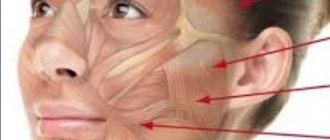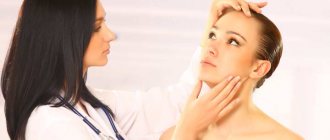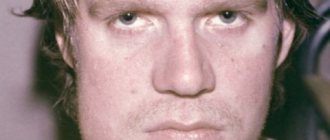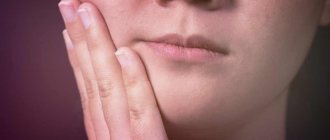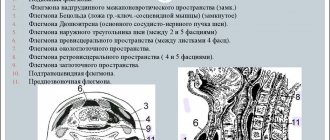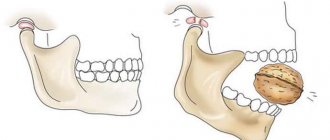There are four muscles of mastication on each side of the face, which provide support and movement of the lower jaw. Violation of contractile processes in the muscles leads to hypertonicity. Chronic spasm causes persistent pain, leads to the formation of trigger points and dental problems. The most common cause of the condition is stress and emotional tension. Medicines, relaxation, gymnastics and facial massage help to get rid of hypertension.
Why does facial muscle tension occur?
With increased tone of the facial muscles, wrinkles form faster, so you need to do gymnastics
The condition of the facial and masticatory muscles of the face depends on the emotional and physical health of a person. Under the influence of stress, high loads or mental tension, muscle tone increases. The condition can be temporary or permanent. With prolonged tension, hypertonicity of the masticatory muscles develops and trigger points are formed.
Causes of pathology:
- A prolonged state of stress - overwork, insomnia, psychological problems and worries lead to tension in the facial muscles. The emotional state is manifested by the appearance of wrinkles on the forehead, in the corners of the eyes, near the nose and mouth, and clenching of the jaw.
- Diseases of the musculoskeletal system - tension in the facial muscles can be associated with pathologies of the cervical and thoracic spine (osteochondrosis, arthrosis, hernia), general joint disease, myositis, chronic tension in the cervical-collar area.
- Injuries (crack, dislocation) of the jaw - mechanical damage to the integrity of bones, tissues and ligaments.
- Inflammatory processes in the oral cavity - periodontitis, pulpitis, periosteal abscess.
- Dysfunction or arthritis of the temporomandibular joint is the ball-and-socket joint that controls the movement of the jaws. Pathology occurs due to malocclusion, bruxism, infection or injury. Rheumatoid arthritis, an autoimmune disease, causes the joint to become inflamed, causing stiffness and pain.
Possible but rare causes include tetanus. Specific bacteria produce a toxin that causes contraction of the jaw muscles. The habit of chewing on one side of the mouth, sleeping on one side, and constantly supporting the cheeks with your hands leads to an unpleasant condition.
A crunch in the jaw joint is a signal of tension in the facial muscles.
Symptoms of facial muscle tension:
- uncontrolled grinding of teeth with damage to enamel;
- swelling;
- muscle soreness;
- biting tongue and cheeks;
- crunching in the temporomandibular joint when opening the mouth;
- limited mobility.
As a result of abnormal tension, muscles lose their ability to stretch normally, and their mass and density increase. At the same time, the oval of the face changes, the lower third becomes larger, longitudinal wrinkles and jowls appear. One of the consequences of the condition is frequent headaches.
Experts associate a temporary increase in tone with increased physical activity or prolonged exposure to a static position.
Tension and pain in the muscles of the face and head
The face is the most exposed area. It most of all reflects our mental and physical state. From time to time, looking in the mirror, we, unfortunately, do not pay attention to the fact that the facial muscles are tense. We are accustomed to hiding our thoughts and feelings, wanting to maintain the boundaries of decency, and a kind of conflict occurs between the internal and external. This is the cause of the resulting muscle tension; the muscles “record” it. Over time, such a chronic condition distorts facial features, which acquire a frozen expression and become like a mask. This is especially noticeable in older people. It turns out that a person’s life, or, more precisely, his attitude towards it and towards others leaves an imprint on his face. Thus, a fate full of disappointments and failures is visible not only in a lost look and a pale complexion. Sorrows and sorrows are stored in clenched muscles and skin folds.
Tense muscles are the main cause of the phenomenon of premature aging of the face. Located under the skin, they give it shape and determine its outline. When the muscles contract, the skin wrinkles and facial folds appear. If muscle tension is a constant phenomenon, if relaxation does not occur, then deep wrinkles gradually appear. Massage gives amazing results. Changes in the relief of the furrows on the forehead are especially noticeable. However, manipulations not only smooth out wrinkles, but also soften the facial expression, removing the stamp of concern from it. In addition, massage movements, affecting the nerves passing under the skin of the forehead, have a positive effect on brain function.
The head is another area in which we, as a rule, are not aware of the constant tension. And in vain. When the supracranial muscle, which covers the head, contracts due to our emotional state, a headache can occur. Knowledge workers are more likely to suffer from this. After the massage, the patient gets a feeling of lightness and clarity in his head, he feels several years younger.
The head and face are often the most stressful areas. Their massage promotes overall deep relaxation and significantly improves a person’s appearance.
Face and head
The face is a relatively small area containing many complex muscles. They differ from other skeletal muscles in that, being located above the bones, they do not move them when they contract under the influence of nerve impulses. This structure allows the face to take on many different expressions. The only exception is the lower jaw - the only movable bone of the face. It articulates with the skull at the temporomandibular joints just in front of the ears, allowing a person to make chewing and swallowing movements. The masticatory muscle is most susceptible to tension. It accumulates there, especially in people who often clench their jaws or grind their teeth.
The lips are surrounded by the orbicularis oris muscle and the muscles that lift the corners of the mouth, and directly by the palpebral fissure - the orbicularis oculi muscle. The frontal belly of the supracranial muscle lies on the forehead. When a person frowns, clenches his jaw, or squints his eyes, he experiences tension in his facial muscles. Facial massage helps release it. If left, it will keep the muscles in a state of chronic contraction, causing headaches, wrinkles, deep folds and furrows on the forehead. Facial massage can, on the one hand, relax tight, tense muscles and, on the other hand, increase the tone of those muscles that are underused and therefore wrinkled, making the skin saggy (usually around the jaw).
The head provides blood supply to the brain. Head massage stimulates this process and prevents stagnation. Otherwise, a headache may occur. Most often - in the middle of the forehead. It can also appear on the sides of the head (temporal region) and in the upper part (parietal region). As a rule, people who have a constitutional predisposition to poor blood circulation or pathological changes in the walls of the arteries are prone to pain in the parietal region. In the occipital region, at the base of the skull, pain usually occurs due to tension in the trapezius muscle, which impedes blood flow and causes congestion. The sinuses are empty cavities in the skull lined with mucous membrane. They are needed to make the skull lighter. In addition, the sinuses provide resonance and enhance the sound of the voice. They are located in the frontal part of the head and lower on both sides of the nose. When an infection occurs, the mucous membrane of the sinuses, and sometimes the bone walls, can become inflamed and swollen, and then acute pain may occur. The maxillary (maxillary) sinuses are especially susceptible to infection, for example, due to dirty water entering them during bathing. Massaging the forehead helps stimulate lymphatic drainage and thus relieves the debilitating pain that sometimes accompanies chronic sinusitis, an inflammation of the sinuses.
MUSCLES OF THE FACE AND HEAD
The numbers correspond to the points of the massage sequence described below and show at what stage the corresponding muscle is treated. The numbers in bold refer to a series of head techniques.
The face is the most difficult area to massage due to its small area and huge number of muscles. The frontal belly of the supracranial muscle, the zygomatic muscles, and the orbicularis oris muscle are among the facial muscles. The masseter muscle belongs to a group of muscles that raise and lower the lower jaw during chewing. The protrusion of the zygomatic process of the upper jaw can be felt directly under the eye. Several facial muscles are attached to it. The bones of the face, together with the bones of the skull, form a kind of frame for the head.
Common Disorders
Before you begin massaging a patient, ask if he or she has any serious health problems. Below is a list of the most common complaints related to the face and head area. Advice is given on how to act in this or that case, whether massage will help and when consultation with a specialist is necessary.
• Headache Undoubtedly the most common complaint. Eye strain, overeating, clogged sinuses, muscle tension - all this causes headaches. Massage can provide significant benefits. Here is a description of work in four zones in which pain is mainly localized. Massage can also be used for migraines, when half of the head hurts, but first you need to focus the pressure on the area where the pain occurs. The massage is enhanced by using one drop of peppermint oil and three drops of lavender oil per teaspoon of carrier oil.
Base of the skull Place your fingertips under the base of the skull, palms facing up. Apply pressure with your fingertips to the problem area for 30 seconds. Then move them slowly and deeply in circular motions.
Forehead
For headaches in this area, very deep pressure usually helps. Start with move 1 and then perform all the massage movements for the forehead.
Whiskey
Apply circular motions with your thumbs. Start by applying pressure for 30 seconds, just make sure that it is increased and released gradually.
crown
Perform the entire sequence of massage movements for the head, repeating each technique with pressure with your thumbs four times.
• Neuralgia
This is a catch-all term for any pain of unknown origin, possibly caused by the damaging effects of a virus on nerves. If we are talking about prolonged pain in the facial nerves, then in this case you should definitely consult a doctor; massage can only be performed with his permission.
• Sinusitis
Inflammation of the sinuses is the cause of both headaches and facial pain. Massage in this case is very effective. Focus on stroking from top to bottom along the nose and cheeks. Repeat them five times. Perform pressure on the points at the base of the nostrils five times, holding each one for 10 seconds. Following these steps, add two drops of rosemary to the vegetable oil.
• Convulsions
In the event of a sudden interruption of blood flow to one half of the body, the muscles find themselves in a compressed, tense state. Skillful massage helps well in such situations. And if you make a mixture of one drop of lavender oil, two drops of neroli and vegetable oils, the results will exceed expectations.
Eliminating the cause of overstrain of the masticatory muscles
Spasms of masticatory muscles on the right
Relaxation of the masticatory muscles is possible only after eliminating the factor that provoked hypertonicity. If the cause of the condition is dental problems, then treatment by a specialized specialist will be required. It consists of correcting the bite using aligners or trainers. In advanced cases, surgical intervention is performed.
If the tension is caused by psychological factors, the doctor prescribes medications that help restore the normal state of the nervous system and psyche. At the early stage of stress, these are mild sedatives; in case of developed depression, tranquilizers and antidepressants are prescribed. Mastering relaxation techniques and working with a psychotherapist will help. Taking vitamin-mineral complexes is indicated.
Improvement in the condition resulting from spinal pathologies will occur after a course of therapy with a vertebrologist or orthopedist. Complex treatment includes taking medications, physiotherapeutic procedures and reflexology, therapeutic exercises, and spinal traction.
It is necessary to exclude regular muscle fatigue during sedentary work. It is important to properly arrange your workplace, have a comfortable chair, and take short breaks to warm up. It is advisable to start the day with gymnastic exercises to stretch the upper body.
How to relax the jaw muscles of the face
Doctors offer several ways to relax the chewing muscles of the face.
Use of muscle relaxants
Antispastic drugs are used to reduce muscle tone. They come in the form of tablets and injections. The medicine has a relaxing effect, pain goes away, and normal muscle mobility is restored. Muscle relaxants are indicated for low tension; in difficult situations they are ineffective. Reception is carried out under the supervision of a doctor, in the prescribed dosage. The drugs have side effects.
Botox injection
Botox injections are used to treat hypertension in the head and neck area. The administration of botulinum toxin preparations promotes long-term muscle relaxation. The product eliminates compression of nerves and blood vessels, restores normal blood circulation. The original density of muscle tissue returns and trigger points disappear. The effect occurs within a few days and lasts for 6 months.
Physiotherapy
Relieving tension from facial muscles using the Darsonval device
To relieve tension in the facial muscles, darsonvalization is indicated. This procedure involves local exposure to current pulses to improve metabolic processes in tissues, relax tension, and increase skin elasticity. Ultrasound therapy can relieve swelling, soreness, and relax muscle fibers. Acupuncture sessions are useful.
Auto-training helps you relax and relieve severe stress. The person himself sets the mood for relaxation and calm. Experts offer many options for abstracts suitable for various situations. Psychological training should take place at home, in comfortable conditions. You need to take a comfortable position, close your eyes, turn on quiet music.
In order for treatment to give a positive long-term result, it is performed comprehensively. In addition to doctor's prescriptions, you need to do facial exercises and massage yourself at home.
Gymnastics for the face
Gymnastics to relax facial muscles
Muscle training allows you to restore the contours of the face, strengthen its frame, get rid of sunken cheeks and eyebrows shifted towards the bridge of the nose. It restores the elasticity of the fibers and their ability to stretch. Facial gymnastics includes exercises that alternately contract and relax muscles.
To remove chronic tension in the jaw area, the following algorithm is recommended:
- Warm up the chewing muscles by lightly stroking them with your pads or knuckles.
- Place 4 fingers under the cheekbone at the level of the ear canal. Press it to your face and open your mouth, using your fingers to lightly press on the muscle, helping it stretch. Lower your jaw and move it forward slightly. Freeze in this position for 1-2 minutes. If there is a slight pulling sensation on the side, everything is done correctly.
- A simple but effective exercise: open your mouth and insert a wine cork between your teeth. Hold it for 5 to 10 minutes.
- Place the palms of both hands on the temple area. Open and close your mouth 15-20 times. The temporalis and masseter muscles are worked simultaneously.
The complex is performed daily. The general condition of the facial muscles will be improved by simultaneous exercises for the cheeks, eyes, and mouth.
To determine overstrain of the masticatory muscles, a simple test is performed: open the mouth wide and insert the palm of your hand. If 4 fingers fit in, this is a normal condition; if less than three fit, there is a spasm. It is necessary to work on the problem by doing exercises and massage.
How psychology can help you cope with jaw muscle tension
As we found out above, clenched jaws are an attempt to hold back crying, screaming or anger. As long as we hold back these emotions, the jaw will strain to keep it all inside. We need to gain strength and let ourselves go, let them spill out. To throw out emotions, that is, to experience, feel them, surrender to them and see how they lose their power and disappear. Special exercises will help us with this. The first of them is imitation of crying. By imitating crying, we engage exactly those muscles that restrain it and thereby actualize them. Second exercise, grimacing. By grimacing, we also activate the “switched off” muscles involved in expressing emotions. These two simple exercises will help us break through the muscular shell and get rid of the negative emotions that it holds back, and as a result we will eliminate the cause of a tense jaw.
If you find it difficult to process your emotions, then you can work through them with your psychologist, which will speed up the process.
There are also methods for getting rid of tense jaw muscles and the stress that causes this tension, for example, the RESET method by Philip Rafferty, but this will be a separate article.
